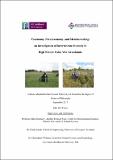| dc.description.abstract | Wet grassland habitats characterised by seasonal inundation and low-intensity agricultural practices support a rich mosaic of plant and animal communities. Whilst most of the conservation strategies aimed at protecting these areas of high nature value focus on botanical and/or ornithological interests, these areas also harbour a significant diversity of invertebrate species. However, the inclusion of invertebrates in conservation planning is normally limited to iconic species such as bees or butterflies with the majority of other invertebrate groups overlooked. This exclusion is driven by factors related to a deficiency of information on distributions, and difficulties associated with the identification of hyper-diverse orders. The need to develop means of including a broader range of invertebrates in the assessments of such High Nature Value (HNV) wet grasslands and generating new information on invertebrate diversity within these areas provided the incentive for this study. Chapter one gives an introductory overview of wet grasslands as high nature value areas, and identifies soultions to inclusing invertebrate diversity in the selection and monitoring of these habitats.
Chapter two investigates the capture of insects in wet grassland habitats, with a specific focus on one potential bioindicator group, namely Diptera: Sciomyzidae. Sciomyzid capture in two wet grassland habitat types with markedly different vegetation structure (rush dominated and sedge dominated wet grassland) was examined using three different sampling methods: Sweep net, Malaise Trap, and Emergence trap. The results illustrated that sweep nets were not effective at capturing Sciomyzidae from sedge dominated wet grassland. Species collections differed according to capture method with a marked variation between sweep nets and Malaise traps in rush dominated wet grassland. However, no capture method comprehensively collected all species observed in the short-term pilot study. The results imply that multiple sampling methods may be required to produce comprehensive inventories of aerial invertebartes where assessments are conducted over restricted time periods. The investigation also suggests that synecological studies of Sciomyzidae in wet grasslands should include the use of Malaise traps which are effective in both long and short vegetation.
Chapter three examines the role that two habitat categories of wet grassland (rush and sedge dominated wet grasslands) play in maintaining the diversity of two Diptera families (Sciomyzidae [marshflies] and Syrphidae [hoverflies]). Using analysis that considered spatial, temporal, and spatiotemporal partitioning of diversity, the results highlight that both habitat types significantly contribute towards the maintenance of the overall gamma diversity of both dipteran families. This is despite rush dominated wet grassland being largely considered ecologically and productively inferior to sedge dominated areas. Managing and maintaining wet grassland habitat heterogeneity in wet grasslands, characterised by different vegetation types, is crucial to conserving these two dipteran families. The results of this work illustrate that wet grassland with abundant rush cover has a significant role to play in the conservation of wet grassland invertebrate species and should be considered as a ecologically important habitat.
In chapter four, the use of two dipteran families (Sciomyzidae and Syrphidae) were investigated as surrogates of broader dipteran diversity; a potential strategy for the inclusion of Diptera in conservation objectives. The study examined community congruence among three dipteran assemblages (Sciomyzidae, Syrphidae, and nine other dipteran families identified as parataxonomic units [PUs]) whilst accounting for environmental variability, scale of observation, and habitat type. Sciomyzidae and PUs demonstrated strong patterns of cogruence at low spatial scales (individual traps), and displayed similar community differentiation based on habitat type. When wet grasslands were further differentiated into two habitat categories (rush and sedge dominated), the significance of community congruence among groups also increased markedly, suggesting a need to examine congruence of communities within categorized units such as habitat types. These results also imply that invertebrate assemblages which exhibit comparable ecological partitioning and similar responses to spatial scale are more likely to be useful surrogates of one another. Correlations between the richness, abundance, and Shannon’s diversity of groups were observed as highly variable and inconsistent. The results demonstrate compositional analysis of Diptera as an effective means of including this group in biodiversity surrogacy studies, and highlights the need to consider invertebrate diversity at spatial scales untypical of current assessments at farm or field level.
The penultimate chapter of the thesis investigated the potential use of DNA metabarcoding (MBC) technology as a means of examining wholescale aerial invertebrate diversity in wet grassland habitats. Using taxonomic and parataxonmic datasets for comparison with the MBC data, the richness and diversity of two contrasting wet grassland habitats were investigated; namely rush and sedge dominated areas. The results indicated that rush dominated wet grasslands were significantly more diverse based on the MBC data; highlighting its potential importance to maintaining invertebrate diversity. Rush wet grassland also exhibited a significantly higher Local Contribution to Beta Diversity based on MBC sequence data, suggesting that at a molecular level these habitats have higher numbers of uncommon assembalges of invertebartes. Using all three datasets, the study also examined successional changes in the community structure of wet grassland invertebrates which is largely unreported. The results illustrate novel findings into aerial invertebrate community turnover which exhibits a series of distinct compositions that follow a cyclical pattern of succession. Finally, the taxonomic and parataxonomic groups examined in the study proved useful as surrogates of the overall community (as represented by MBC data) in terms of community congruence; illustrating for the first time that the use of selected a pirori groups to monitor wholescale invertebrate diversity is feasible.
Chapter six summarizes the main outcomes of the four preceding chapters through the establishment of key points and examines the potential of including Diptera and wider aerial invertebrate diversity in conservation strategies. The discussion also examines the implications of the findings within the context of the current conservation framework, and highlights areas in need of further research. | en_IE |


